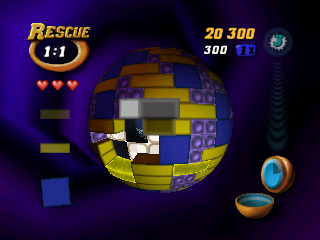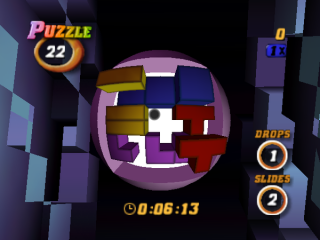Overview
 This is not your average game of Tetris!
This is not your average game of Tetris!Tetrisphere is a 3D tile-matching puzzle game developed by H2O Entertainment and published by Nintendo for the Nintendo 64 in North America on August 11, 1997, with a European release on February 1998.
Advertised as "a whole new way to play Tetris", Tetrisphere tasks players with clearing groups of tetrominoes and trominoes from a multi-layer 32×32 spherical board by sliding pieces on the board and then dropping new pieces of the same shape and color touching them. Similar to Tetris Attack, the game has little similarity with the classic "falling block" game of Tetris.
The game was originally prototyped as an Atari Jaguar title, named "Phear", prior to Nintendo picking up the game as a Nintendo 64 title with the Tetris branding. The studio later worked on a more traditional Tetris title with The New Tetris.
Gameplay
Tetrisphere tasks players with clearing groups of tetrominoes and trominoes from a multi-layer 32×32 spherical board (or "sphere") in order to expose the core layer's tiles (or "cores").
Pieces
There are five different types of pieces based on shape and color, which cannot be rotated. Pieces can only be considered "connected" in the same layer if they are either strictly adjacent (where all edge tiles, horizontally or vertically, must touch the other's) or loosely adjacent (where they are connected as long as one edge tile is touching the other). They are "connected" to lower layers if they share the same position on the board.
- Blue, Square - Tetromino. Strictly adjacent.
- Yellow, Horizontal Bar - Tromino. Strictly adjacent.
- Green, Vertical Bar - Tromino. Strictly adjacent.
- Purple, "L" - Tromino. Loosely adjacent.
- Cyan, Vertical "Z" - Tetromino. Loosely adjacent.
- Red, "T" - Tetromino. Loosely adjacent.
In addition, the game includes wildcard "?" tiles that can be dropped onto any tile. They also provide a 1-tile shadow, allowing players to slide any piece on the board (rather than those of the chosen shape).
Magic
The game's power-up system, Magic is earned when players clear 20 or more pieces in a single combo and is used to clear or manipulate a large group of pieces.
- Firecracker - Eliminates a small section of pieces on the sphere.
- Bundle O' Dynamite - Gets rid of pieces that are in a spread.
- Electro Magnet - Pulls pieces away from the sphere like a magnet.
- Atom - Literally peels the top layer of the sphere like an orange.
- Bomb - Eliminates a great amount of pieces.
- Ray Gun - Cuts though and removes pieces though the core.
Bots
The game includes eight playable "bots", each determining the player's cursor speed normally (Speed) and when dragging pieces (Power).
- Wheels - Default. Equal in both Speed and Power.
- Rocket - Highest Speed, Lowest Power.
- Gear - High Speed, Low Power.
- Turbine - Equal in both Speed and Power.
- Stomp - Lowest Speed, Highest Power.
- Gyro - Low Speed, High Power.
- Jak - Low Speed, High Power.
Game Modes
Rescue
The main level-based mode of Tetrisphere, Rescue tasks players with removing a group of 2×2 "cores" from the core layer of the board in order to free a round bot from the center. Cores are removed once they are revealed in whole, and the bot can escape once it can fit through the gap.
The mode includes 100 total levels, split into ten Episodes.
The game also includes a hidden variation of Rescue, known as Lines, where players cannot drop new pieces, instead sliding pieces around to form "lines" of three or more of the same piece to clear them. Only the blue, yellow, and green pieces are used.
Hide + Seek
A mission-based mode, Hide + Seek tasks players with completing multi-stage levels where each stage has a special criteria to meet (usually revealing a select group cores, forming a "picture").
The mode includes 30 total levels, split into five Episodes. Each level includes five stages, with each stage having one of eight goal types. Every fifth stage is the Hide & Seek stage.
- Multi - The core layer is made up of a repeating picture. The objective is to uncover one of these pictures in whole.
- Drill - Several 1×1 "Drill" tiles are on the board, which clears that location down to the core once the tile is cleared. The objective is to uncover the core picture in whole, of which one Drill tile reveals its whereabouts.
- Brick - There are some "brick" pieces on top of the board that cannot be slid. Instead, they must be dropped using gravity down to the core. The objective is to let one of these pieces hit the core.
- Tower - The core picture is hidden underneath a large "tower" of pieces that cannot be manipulated at all. The objective is to reveal all core picture tiles surrounding the tower.
- Unique - The core picture is a weird shape, which must be revealed using the Drill tile. The objective is to uncover the picture in whole.
- Shift - The core contains multiple 2×2 pictures, each obscured by a Drill tile. The objective is to use the Drill tiles to reveal them, then slide them using the Blue piece shadow to form the final picture.
- Connect - The core contains multiple pictures linked together, one of which is revealed with the Drill tile. The objective is to reveal all core picture tiles in whole.
- Hide & Seek - Essentially the "Rescue" mode. It serves as the "boss" of each level.
Puzzle

Focused on more thoughtful gameplay, Puzzle is a series of 100 unique puzzles, where each puzzle has a unique pre-determined layout and limitation on the amount of drops and the amount of slides.
Unlike other modes, there is no time limit nor any power-ups. Additionally, players must clear all pieces from the board, rather than exposing the core layer.
Time Trial
Focused on quick gameplay sessions, Time Trial gives players five minutes to earn as many points as they can through high-scoring combos, revealing cores, and clearing boards. Once a core is revealed and the core is ended, the sphere is cleared and reset with a new assortment of pieces.
Vs.
 In the VS. modes, things can get a bit busy.
In the VS. modes, things can get a bit busy.The game's multiplayer mode, with players competing against an A.I. opponent in the single-player Vs. CPU mode or against another player in Vs. mode.
Both players race to reveal a certain amount of whole "cores" on their board first, or to have their opponent lose all three of their hearts first.
This mode is unique for having special garbage blocks, known as "Dark Pieces", which are dropped on the opponent's board after forming combos of four or more pieces. These cannot be cleared by dropping pieces onto them, with players instead having to drop pieces onto regular pieces connected to them (which can further increase the amount of garbage blocks volleyed).
Log in to comment